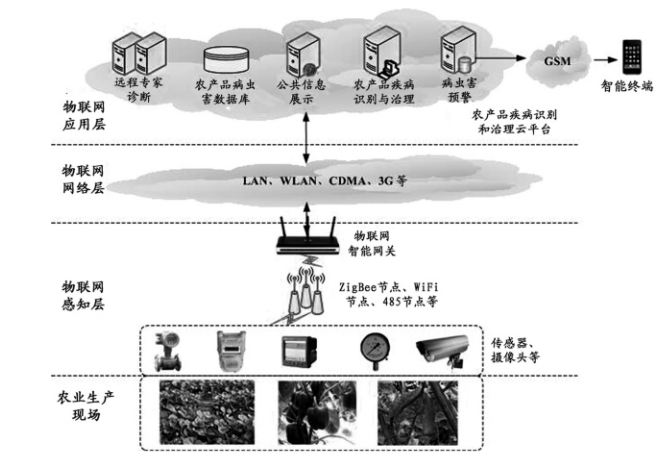The connotation of the Internet of Things and smart agriculture is combined with the actual situation of agricultural intelligent production to design the smart agricultural Internet of Things architecture, which mainly includes the Internet of Things perception layer, the Internet of Things network layer and the Internet of Things application layer. At the same time, the application of the Internet of Things in smart agriculture was specifically studied through the agricultural product disease identification and treatment system.
Smart Agriculture IoT Application Cases
The agricultural product disease identification and treatment system has become an important driving force for the sustainable development of the agricultural economy and a necessary means to ensure farmers’ income. This article takes the agricultural product disease identification and treatment system as an example to explain the application of the Internet of Things in smart agriculture. The system structure is shown in the figure.

1) Use intelligent sensors and video monitoring equipment at the networked perception layer to establish an agricultural production site monitoring network, collect on-site crop growth environment data (such as sunshine, temperature and humidity, etc.) and crop growth status image data, and transmit them through ZigBee nodes and WiFi nodes , 485 nodes, etc. are transmitted to the IoT smart gateway. After the data is summarized and processed, the data is automatically uploaded to the IoT network layer.
2) The IoT network layer transmits the acquired data information to the application layer of the IoT through the mutual integration of LAN, WLAN, CDMA and 3G.
3) Build a standardized agricultural product pests and diseases database and a remote expert diagnosis center at the Internet of Things application layer, and compare and analyze the data collected on site with the data in the agricultural product pests and diseases database to identify crop pests and diseases; for some diseases and pests that cannot be compared The pests and diseases identified in the database can be diagnosed through remote expert diagnosis centers to accurately determine crop diseases and make the most reasonable management decisions. In addition, through early warning of pests and diseases, relevant channels (such as mobile phone short messages, etc.) are used to convey information about upcoming pests and diseases to farmers, and remind farmers to carry out timely prevention and control. At the same time, public information display platforms (such as electronic large screens, etc.) are used to display crop-related information in real time, such as the conditions of the growing environment, growth status, possible pests and diseases, and prevention and control methods for farmers’ reference.
Outlook
The development of the Internet of Things provides unprecedented opportunities to accelerate the realization of intelligent agriculture in our country, and will also profoundly affect the future of modern agriculture. At this stage, my country has a certain technical and industrial foundation for using the Internet of Things to accelerate the development of smart agriculture. However, there are still some problems in the key technologies and standard systems of the smart agricultural Internet of Things. Solving these problems requires the joint efforts of the government, enterprises, scientific research departments and various industries. It is foreseeable that in the near future, the Internet of Things will bring revolutionary changes to the agricultural field.
Parole chiave: terminale di trasmissione dati